
 |
Tea Clipper |
 |
| from TeaAntiques.com | ||
| Edition Ninety Two |
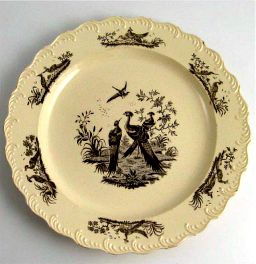 A
charming Leeds Creamware circular plate with a very attractive 'feather moulded'
rim, c1790. This delightful Creamware pottery plate is decorated with 'fancy bird'
landscape prints in black monochrome. The body of the plate is of a beautiful soft
cream colour.
A
charming Leeds Creamware circular plate with a very attractive 'feather moulded'
rim, c1790. This delightful Creamware pottery plate is decorated with 'fancy bird'
landscape prints in black monochrome. The body of the plate is of a beautiful soft
cream colour.
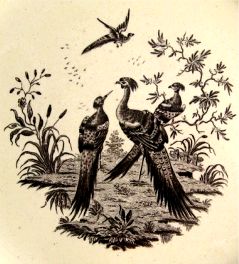 In
the centre of the plate is the main fancy bird print. This shows three large exotic
birds on the ground looking up at a bird flying close overhead. These birds are
depicted within a landscape that includes a small section of picket fence, trees,
shrubs and bull rushes.
In
the centre of the plate is the main fancy bird print. This shows three large exotic
birds on the ground looking up at a bird flying close overhead. These birds are
depicted within a landscape that includes a small section of picket fence, trees,
shrubs and bull rushes.
Around the rim of the plate are six further prints equally spaced showing more exotic bird scenes, each one different. They all show a pair of fancy birds in various positions within a landscape setting.
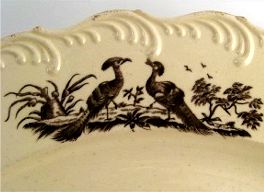
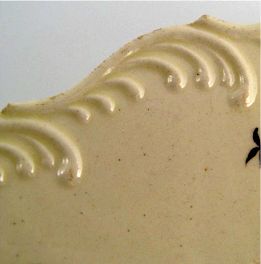
With the beautiful moulded feather type boarder, it is an elegant Creamware plate dating from c1790.
More details of this item and other tea related antiques can be found by visiting my web site at www.TeaAntiques.com.
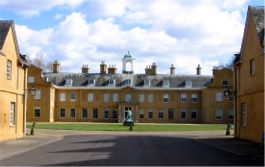 After
the great victory by the Great Duke of Wellington at the battle of Waterloo in 1815,
the nation voted him a large sum of £600,000. With this he was to buy himself country
house befitting him. He considered several houses which were offered to him, including
Uppark and Bramshill. However, he settled on Strafield Saye, situated between Reading
and Basingstoke and conveniently close to London and the Royal court.
After
the great victory by the Great Duke of Wellington at the battle of Waterloo in 1815,
the nation voted him a large sum of £600,000. With this he was to buy himself country
house befitting him. He considered several houses which were offered to him, including
Uppark and Bramshill. However, he settled on Strafield Saye, situated between Reading
and Basingstoke and conveniently close to London and the Royal court.
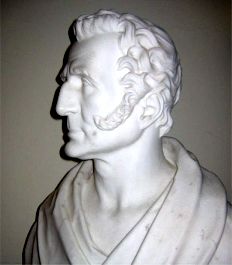 Stratfield Saye
when he bought it, was not a grand house, but a relatively modest Carolean house
of red brick built in 1630 by Sir William Pitt, Comptroller of the Household to
King James I. This original house had been altered, mainly inside, between 1730
and 1790. When the Duke of Wellington took the house, he had plans to build a vast
Palace on the ground on the other side of the river to this house and then to demolish
this one. Various plans were drawn up by leading architects, Benjamin Wyatt and
Charles Smirke. These plans showed a Palace that was to rival the vast Palace of
Blenheim build for the Duke of Marlborough some 100 years earlier. However, with
the Duke of Wellington buying Apsley House in central London and Stratfield Saye,
it soon became clear to him that his funds were not going to be sufficient to carry
out this grand building scheme. So, instead he settled upon improving the existing
house of Strafield Saye, making it into a more comfortable home than a vast Palace.
Stratfield Saye
when he bought it, was not a grand house, but a relatively modest Carolean house
of red brick built in 1630 by Sir William Pitt, Comptroller of the Household to
King James I. This original house had been altered, mainly inside, between 1730
and 1790. When the Duke of Wellington took the house, he had plans to build a vast
Palace on the ground on the other side of the river to this house and then to demolish
this one. Various plans were drawn up by leading architects, Benjamin Wyatt and
Charles Smirke. These plans showed a Palace that was to rival the vast Palace of
Blenheim build for the Duke of Marlborough some 100 years earlier. However, with
the Duke of Wellington buying Apsley House in central London and Stratfield Saye,
it soon became clear to him that his funds were not going to be sufficient to carry
out this grand building scheme. So, instead he settled upon improving the existing
house of Strafield Saye, making it into a more comfortable home than a vast Palace.
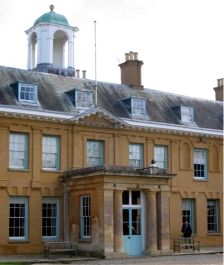 The
old Carolean house still forms the essential core of the house, although the red
brick was covered in a stucco. He was to add the two outer wings to the house, keeping
the same style of building. This style, as seen in the original stable blocks on
either side of the drive leading up to the house, was rather Dutch in appearance.
Certainly the shape of the gables on the stables is reminiscent of Dutch architecture.
In these gables is a clock on one stable block and a wind direction indicator on
the other. Horses were an important part in the life of the Duke of Wellington,
so fitting that the stable blocks were so dominant to the position of the house.
The
old Carolean house still forms the essential core of the house, although the red
brick was covered in a stucco. He was to add the two outer wings to the house, keeping
the same style of building. This style, as seen in the original stable blocks on
either side of the drive leading up to the house, was rather Dutch in appearance.
Certainly the shape of the gables on the stables is reminiscent of Dutch architecture.
In these gables is a clock on one stable block and a wind direction indicator on
the other. Horses were an important part in the life of the Duke of Wellington,
so fitting that the stable blocks were so dominant to the position of the house.
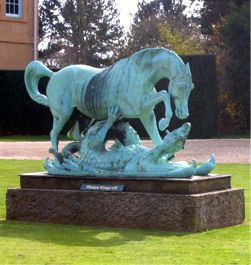 As
you approach the West front of the house today, it is dominated by a large bronze
statue in the lawn of the turning circle. this statue shows a horse trampling a
dragon. It is in fact an incomplete statue as the horse should have a rider as the
statue is meant to be of George and the dragon.
As
you approach the West front of the house today, it is dominated by a large bronze
statue in the lawn of the turning circle. this statue shows a horse trampling a
dragon. It is in fact an incomplete statue as the horse should have a rider as the
statue is meant to be of George and the dragon.
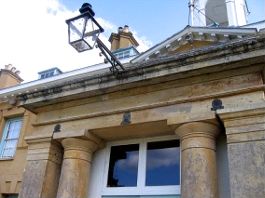 The
stucco covering of the house is now of a sandstone colour, but was originally white
when put up. There is nothing architecturally fantastic about the house, which is
but a country gentleman's home. There are sash windows, some of which do have the
original 'double glazing' and above the entrance porch, some fire insurance plaques.
It is not so much the house that visitors come to see, but the contents relating
to the achievements of this great man.
The
stucco covering of the house is now of a sandstone colour, but was originally white
when put up. There is nothing architecturally fantastic about the house, which is
but a country gentleman's home. There are sash windows, some of which do have the
original 'double glazing' and above the entrance porch, some fire insurance plaques.
It is not so much the house that visitors come to see, but the contents relating
to the achievements of this great man.
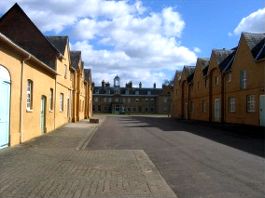
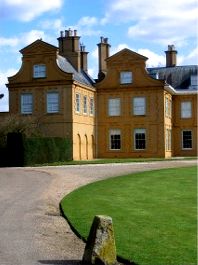
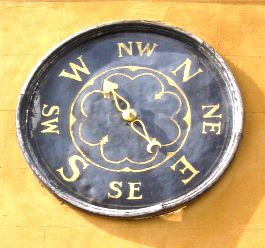
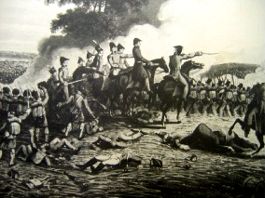 After
the battle of Waterloo, he was showered with gifts from European leaders, which
included great works of art and furniture.
After
the battle of Waterloo, he was showered with gifts from European leaders, which
included great works of art and furniture.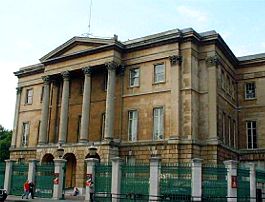 Many of these things were house in the rather more grand Apsley House in London,
his town house. The rest were to be housed here at Stratfield Saye. It soon becomes
apparent that many of these items were not designed to be housed in such a modest
home, but something much larger and grander. The first room you see is the entrance
hall. And in the centre two magnificent Italian marble topped side tables. These
are put back to back in the centre of the hall, rather than used as a pair
of side tables - obviously there just wasn't the space for them! The same goes for
some of the paintings in the halls, were they are full length portraits that should
be hung on high walls, but here take up almost the entire height of the walls. This
Hall, was originally three rooms in the Carolean house with three bedrooms above.
In order to make a more commodious entrance hall, the bedrooms were removed and
the three rooms on the ground floor knocked into one to give the much grander proportions
we see today. There are a series of what appear to be granite ionic columns that
support a gallery along the back of the hall. These are in fact of wood and painted
top look like granite. There are some battle trophies on display in the hall including
a set of tricolour banners embroidered with silver with the Imperial bees. These
were presented by Napoleon to each départment in France and were given up to the
Great Duke upon his entry into Paris after the battle of Waterloo.
Many of these things were house in the rather more grand Apsley House in London,
his town house. The rest were to be housed here at Stratfield Saye. It soon becomes
apparent that many of these items were not designed to be housed in such a modest
home, but something much larger and grander. The first room you see is the entrance
hall. And in the centre two magnificent Italian marble topped side tables. These
are put back to back in the centre of the hall, rather than used as a pair
of side tables - obviously there just wasn't the space for them! The same goes for
some of the paintings in the halls, were they are full length portraits that should
be hung on high walls, but here take up almost the entire height of the walls. This
Hall, was originally three rooms in the Carolean house with three bedrooms above.
In order to make a more commodious entrance hall, the bedrooms were removed and
the three rooms on the ground floor knocked into one to give the much grander proportions
we see today. There are a series of what appear to be granite ionic columns that
support a gallery along the back of the hall. These are in fact of wood and painted
top look like granite. There are some battle trophies on display in the hall including
a set of tricolour banners embroidered with silver with the Imperial bees. These
were presented by Napoleon to each départment in France and were given up to the
Great Duke upon his entry into Paris after the battle of Waterloo.
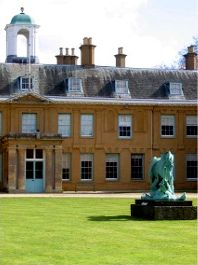 Another
very interesting feature within the Hall are some Roman mosaic floors. These were
put here by the second Duke after their discovery at nearby Silchester. The lamps
that light the hall are the original colza-oil lamps put here by the first Duke,
but have been converted to electricity in 1947.
Another
very interesting feature within the Hall are some Roman mosaic floors. These were
put here by the second Duke after their discovery at nearby Silchester. The lamps
that light the hall are the original colza-oil lamps put here by the first Duke,
but have been converted to electricity in 1947.
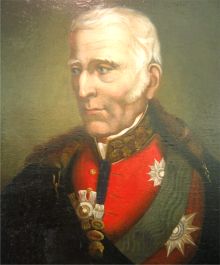 When
the first Duke made his improvements to the house he was to install many innovative
features, such as some of the earliest heating radiators and bedrooms were given
an en-suite water closet. When Queen Victoria came to stay, as she was a great friend
of the great Duke, she was said to have found the house rather stuffy from the heating.
This did not stop her later installing such heating in her Palaces!
When
the first Duke made his improvements to the house he was to install many innovative
features, such as some of the earliest heating radiators and bedrooms were given
an en-suite water closet. When Queen Victoria came to stay, as she was a great friend
of the great Duke, she was said to have found the house rather stuffy from the heating.
This did not stop her later installing such heating in her Palaces!
The Library, which is next to the Hall, is almost as it was when the first Duke was here. This can be seen to be the case in contemporary paintings which pretty well show the same layout and furniture. The decoration is of the early period of the house and dates from 1740, thought to be to the designs of William Kent. There are many beautiful bookcases lining the walls with many of the books those that belonged to the first Duke. He was very keen on books and you will see many of his travelling library chests around the house which he would have taken with him on his travels and battles.
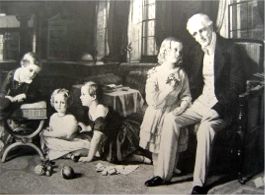 Opposite
this Library and separated only by columns is a small and comfortable family sitting
room beyond which a conservatory housing a swimming pool. This house is still very
much a family home. The current, eight Duke, now lives on the estate having handed
over this main house to his son and his young family. On the wall is a beautiful
little painting by Robert Thorburn, which shows the Great Duke in the last year
of his life, as an old man with four of his five his grandchildren.
Opposite
this Library and separated only by columns is a small and comfortable family sitting
room beyond which a conservatory housing a swimming pool. This house is still very
much a family home. The current, eight Duke, now lives on the estate having handed
over this main house to his son and his young family. On the wall is a beautiful
little painting by Robert Thorburn, which shows the Great Duke in the last year
of his life, as an old man with four of his five his grandchildren.
Leaving the Library you pass through the Staircase Hall, which dates from the original house of 1630 and has the original carved oak staircase. You can also see one of the original metal radiators installed by the Great Duke when he first arrived at Stratfield Saye. This has recently been connected to the current heating system and is in perfect working order.
Moving on, you enter Lady Charles Room, now used much as an office by the current owner's wife. It was named Lady Charles room after Augusta Sophia Pierrepont, who married the Great Duke's second son Lord Charles Wellesey. This room has a beautiful chinoiserie white plaster fireplace. To the right is a painting that shows two horses in stables together with the groom. It is said that the groom was kicked and killed by one of these horses and in revenge, the groom's wife poisoned the horse.
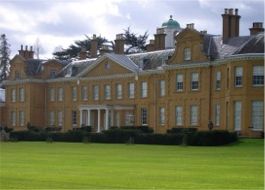 One
of the most remarkable rooms runs along the central portion of the East front of
the house. The Gallery overlooks the park and River Loddon. It was on the land across
the river, that it was originally planned to build the great Palace, but never happened.
One
of the most remarkable rooms runs along the central portion of the East front of
the house. The Gallery overlooks the park and River Loddon. It was on the land across
the river, that it was originally planned to build the great Palace, but never happened.
The Gallery is rather like a grand Gallery but in miniature. It was added to the house by George Pitt in 1745, but has since been redecorated. The walls are lined with many prints stuck onto the wall, many depicting scenes from Shakespeare's plays. Contained in this room are fine pieces of French Boulle and Contra-Boulle furniture, much of which was bought by the first Duke in Paris in 1817. At each end of this long and narrow room are a line of four white and gold ionic columns adding to the proportions of the room. One major feature of the gallery are a series of bronze busts, several of which are partially gilded. These busts include Roman Emperors; Massens, one of Napoleon's marshals; King Charles I of England and King Louis XIV of France.
Along the East front beyond the Gallery are two rooms, a Drawing Room and Little Drawing Room.
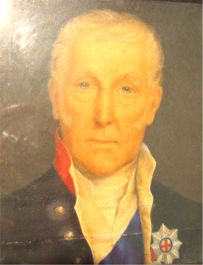
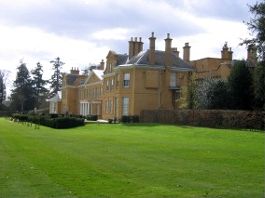 Both
these rooms have their walls lined with original white and gold wallpaper dating
from 1838, put up by the Great Duke. The golden design of the wallpaper is is of
a large repeating delicate floral design and gives the room a very rich and comfortable
feeling. On the walls also hang a delightful set of Chippendale mirrors dating from
the 1750's and were in the house when the great Duke took it over. There are fantastic
and important works of art on the walls. These paintings are from a collection with
an interesting history. During the closing stages of the battle of Vitoria on 21st
June 1813, Joseph Bonaparte fled from the battlefield with his baggage train. A
command of cavalry was sent in pursuit and captured the baggage train, which was
found to contain vast quantities of booty, including these paintings. There were
works of art from the Spanish Royal collection that were found roughly rolled up
with manuscripts, state papers and even love letters - all of which fell into the
British hands. Many of the paintings can now be seen in Apsley House, London, which
was presented to the Nation by the seventh Duke.
Both
these rooms have their walls lined with original white and gold wallpaper dating
from 1838, put up by the Great Duke. The golden design of the wallpaper is is of
a large repeating delicate floral design and gives the room a very rich and comfortable
feeling. On the walls also hang a delightful set of Chippendale mirrors dating from
the 1750's and were in the house when the great Duke took it over. There are fantastic
and important works of art on the walls. These paintings are from a collection with
an interesting history. During the closing stages of the battle of Vitoria on 21st
June 1813, Joseph Bonaparte fled from the battlefield with his baggage train. A
command of cavalry was sent in pursuit and captured the baggage train, which was
found to contain vast quantities of booty, including these paintings. There were
works of art from the Spanish Royal collection that were found roughly rolled up
with manuscripts, state papers and even love letters - all of which fell into the
British hands. Many of the paintings can now be seen in Apsley House, London, which
was presented to the Nation by the seventh Duke.
The Dining Room at the far end of the house was added in about 1775 by Lord Rivers. It now contains a large George III dining table around which are a set of red padded Regency dining chairs and some large pieces of regency furniture, including the mahogany sideboard. The portraits around the walls are family portraits of the Dukes of Wellington.
In a Small Dining room on the West front of the house there are cabinets which house some beautiful porcelain dinner services, many presented to the Duke after his great battle. These services include some exquisite Sèvres porcelain and the Prussian service that was presented to the Duke by Frederick William III of Prussia, this was made in Berlin c1818.
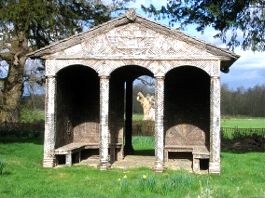
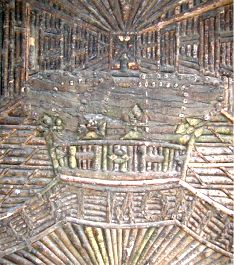
Within the grounds of the house is a summer house, interestingly lined with small wooden branches, sliced in half lengthways and used to create patterns and designs around the formal structure. These include a crown and various buildings.
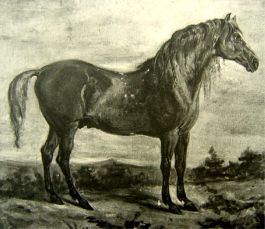
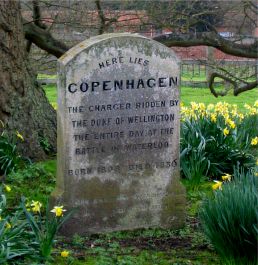 Also
in the grounds is the grave of the Duke of Wellington's horse that he rode during
the battle of Waterloo. Copenhagen, the name of the Duke's favourite charger was
a chestnut stallion of a little over 15 hands in height. The horse was named after
the campaign that Wellington took part in to capture the Danish fleet in Copenhagen
harbour in 1807. The horse was born in 1808 and accompanied and carried the Duke
on his campaigns including the Battle of Waterloo. He had a reputation for kicking
and after the long battle the Duke dismounted from Copenhagen and gave him a sharp
pat on the rump. In reaction, Copenhagen kicked out, narrowly missing the Duke's
head and bolted. He spent a long and happy retirement at Stratfied Saye and was
buried here with full military honours. The grave marked by a grave stone and an
Oak tree, grown from an acorn planted here by the Duke's house-keeper.
Also
in the grounds is the grave of the Duke of Wellington's horse that he rode during
the battle of Waterloo. Copenhagen, the name of the Duke's favourite charger was
a chestnut stallion of a little over 15 hands in height. The horse was named after
the campaign that Wellington took part in to capture the Danish fleet in Copenhagen
harbour in 1807. The horse was born in 1808 and accompanied and carried the Duke
on his campaigns including the Battle of Waterloo. He had a reputation for kicking
and after the long battle the Duke dismounted from Copenhagen and gave him a sharp
pat on the rump. In reaction, Copenhagen kicked out, narrowly missing the Duke's
head and bolted. He spent a long and happy retirement at Stratfied Saye and was
buried here with full military honours. The grave marked by a grave stone and an
Oak tree, grown from an acorn planted here by the Duke's house-keeper.
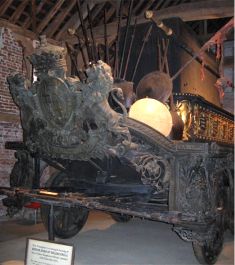 Following
the death of the Great Duke at Walmer Castle on 14th September 1852, he too was
given an impressive funeral in London, where he is buried in St Paul's cathedral.
Prince Albert, the Prince Consort decreed 'that nothing should be wanting in this
tribute of a National gratitude'. Within 18 days a great funeral car was designed
and built to carry the Duke on his last journey. This incredible vehicle is now
on display in the stables at Statfield Saye. It consisted of four different sections
and was richly ornamented. At the base was a carriage with six wheels, made from
bronze cast from French cannons captured at Waterloo. Above the carriage, a swivelling
platform which enabled the coffin to be slid onto a ramp over the steps at St Paul's
cathedral. The platform was decorated with the names of the Duke's victories and
trophies of weapons, helmets, colours and standards.
Following
the death of the Great Duke at Walmer Castle on 14th September 1852, he too was
given an impressive funeral in London, where he is buried in St Paul's cathedral.
Prince Albert, the Prince Consort decreed 'that nothing should be wanting in this
tribute of a National gratitude'. Within 18 days a great funeral car was designed
and built to carry the Duke on his last journey. This incredible vehicle is now
on display in the stables at Statfield Saye. It consisted of four different sections
and was richly ornamented. At the base was a carriage with six wheels, made from
bronze cast from French cannons captured at Waterloo. Above the carriage, a swivelling
platform which enabled the coffin to be slid onto a ramp over the steps at St Paul's
cathedral. The platform was decorated with the names of the Duke's victories and
trophies of weapons, helmets, colours and standards.
Above the platform was the bier, covered with black velvet embroidered with the Wellesley crest and Field-Marshal's batons. Finally above the bier was the coffin itself. On the coffin was placed the usual military regalia of head-dress and sword.
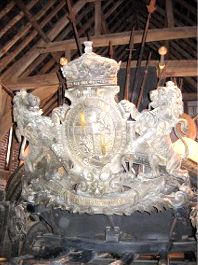
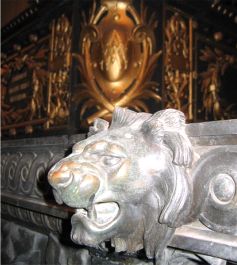
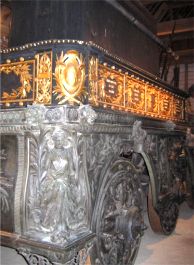
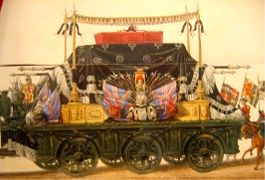 The
funeral car was designed with measurements that would allow it to pass through Temple
Bar gate in the city and was pulled by 12 black dray horses, three abreast. It weighed
18 tonnes, 21 feet in length, 10.5 feet in width and limited to 17 feet in height.
It was one of the greatest funerals seen in this country. Every Regiment of the
British Army was represented and many of the crowned heads of Europe attended. Over
a million people lined the streets of London to watch the procession pass by. Despite
the careful planning, the unwieldy funeral car got stuck in the Mall and Ludgate
Hill and had to be manhandled out of its difficulties. Despite the difficulties,
his body was finally laid to rest in St Paul's.
The
funeral car was designed with measurements that would allow it to pass through Temple
Bar gate in the city and was pulled by 12 black dray horses, three abreast. It weighed
18 tonnes, 21 feet in length, 10.5 feet in width and limited to 17 feet in height.
It was one of the greatest funerals seen in this country. Every Regiment of the
British Army was represented and many of the crowned heads of Europe attended. Over
a million people lined the streets of London to watch the procession pass by. Despite
the careful planning, the unwieldy funeral car got stuck in the Mall and Ludgate
Hill and had to be manhandled out of its difficulties. Despite the difficulties,
his body was finally laid to rest in St Paul's.
Today, Stratfield Saye is a fitting reminder and monument to the Great Duke of Wellington and a fascinating piece of English history. I hope in a future Tea Clipper to visit the Duke's London home, Apsley House and share with you some of the treasures within.
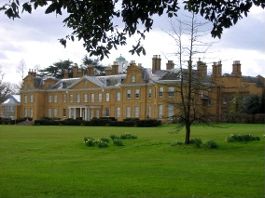
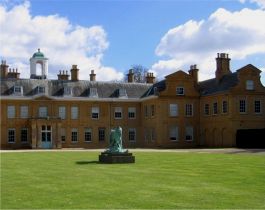
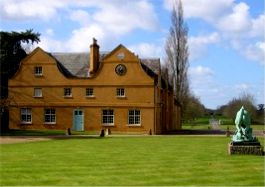
NOTE: Opening times of this house are limited, so please check for details before planning a visit.
To review past newsletters, just follow this link:
Past newsletters.
To subscribe to this free newsletter -
Click here